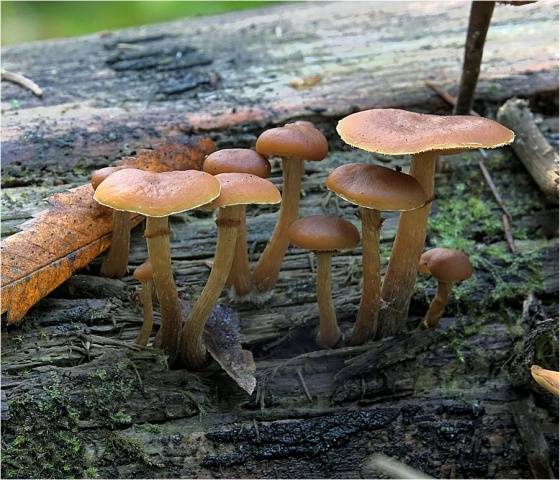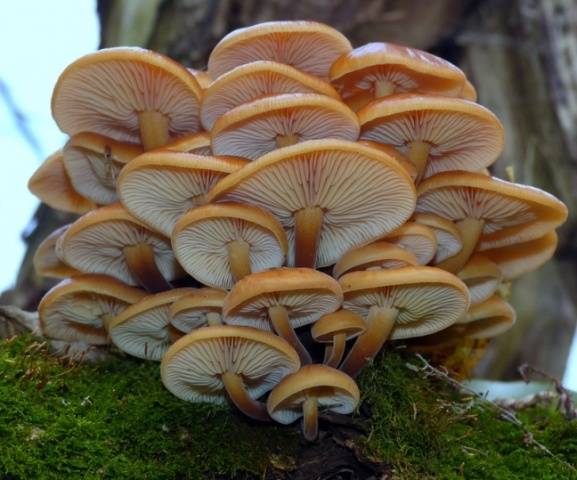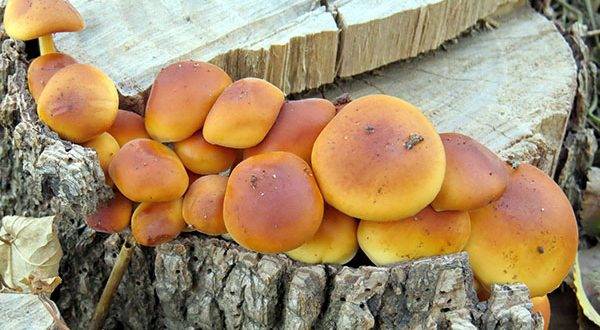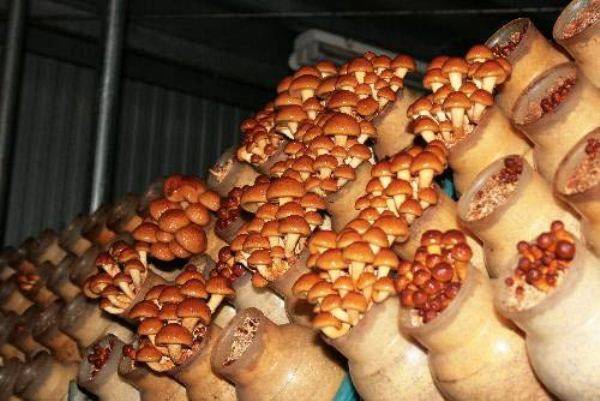Content
Winter mushrooms belong to the edible mushrooms of the row family. In Russian, I often call them winter mushrooms, and in special literature you can find such names as flammulina velvety-legged or colibia velvety-legged.
Winter honey agaric flammulin is a small-sized cap-pedunculate lamellar mushroom. The hat is light brown, yellow-brown. According to the Soviet classification, they belong to the IV category of mushrooms (mushrooms with the lowest nutritional value), but in other countries, for example, in Japan, they are very popular. Photos and descriptions of edible winter mushrooms are given in this article.
Where winter mushrooms grow
Winter mushrooms grow on rotten, dead or weakened deciduous wood. You can meet them in the forest, on fallen trees, on stumps or dead. They are often found on poplars and willows, therefore, these mushrooms can often be found even in city gardens and parks. In the forest, the most common places for their growth are forest edges, forest clearings, roads and old clearings - all those places where there is a lot of old dead wood. Flammulins are typical parasitic fungi, or saprotrophs, that feed on dead wood and participate in its decomposition.
When to collect winter mushrooms
This mushroom is really winter, since winter mushrooms appear in late autumn, in October - November. At this time, it grows most intensively. Frequent thaws also promote the growth of the fungus, and in a warm winter, the winter agaric season can last all three months.
When and where can you collect winter mushrooms in the Moscow region
Flammulina velvety-legged can be found throughout Russia, and the forests near Moscow are no exception. You need to search in deciduous areas, along rivers and streams. The best time to harvest is late autumn, starting in late September. Damp weather is especially conducive to the growth of mushrooms. During prolonged thaws, the growth of fungi resumes, so you can find colonies of these fungi even sticking out from under the snow.
All directions, except for the southern one, are considered to be traditional gathering places for honey agarics in the Moscow region.
How to collect winter mushrooms correctly
Flammulina grows in colonies, so collecting winter mushrooms is quite simple. Often, mushroom pickers only take mushroom caps, since they have a pleasant taste and aroma. The stalk of the mushroom is stiffer and more fibrous. Its lower part must be cut off immediately even in young mushrooms; in older ones, the entire leg is removed.
How to distinguish winter mushrooms from false photos
Flammulina is difficult to confuse with other mushrooms simply because nothing else grows at this time of year. Therefore, to call any mushroom as "false winter mushroom" can be very conditional. In addition, a real winter honey mushroom has a number of features, thanks to which it cannot be confused with other types of honey mushrooms, including false ones. Here are the hallmarks and descriptions of what real winter mushrooms look like:
- The color of the mushroom cap changes from honey to brown towards the center.
- There is always a moist slimy coating on the surface of the cap, which does not disappear even after cooking.
- Flammulina stem is even, smooth, cylindrical in shape.
Among the poisonous mushrooms, which are similar to winter mushrooms, it is possible to distinguish only the bordered gallery (pictured). Due to the fact that these mushrooms ripen at different times, it is almost impossible to meet them together.
Nevertheless, a poisonous mushroom can be distinguished by its characteristic ring on the leg. In the winter mushroom of flammulina velvety-footed (photo below), it is completely absent.
Healing properties of winter mushrooms and rules of application
In addition to culinary qualities, winter mushrooms also have medicinal properties. However, it must be borne in mind that the pulp of the mushroom contains a small amount of toxins that are destroyed during cooking. Therefore, you always need to start cooking winter mushrooms by boiling them in boiling water for at least 20 minutes.
The chemical composition of mushrooms and useful properties
The fruiting body of flammulina contains a large amount of amino acids and protein, ahead of many fruits and vegetables in this indicator. Winter mushrooms contain zinc, iodine, potassium and other trace elements. In addition, the fruit bodies of the fungus contain antioxidants, thanks to which Flammulina is used in cosmetology and pharmaceuticals.
The use of winter mushrooms in medicine and cosmetology
In Japan, inaketake (this is the name of flammulina in Japanese) is valued for its ability to inhibit the development of tumors and neoplasms, including malignant ones. In addition, the healing properties of winter mushrooms are manifested in the support and strengthening of the immune system. They lower blood cholesterol levels and have a regenerating effect on the liver. Cosmetologists use Flammulina as a means to rejuvenate and nourish skin
Who should refrain from eating winter mushrooms
Flammulina, like all mushrooms, is a rather difficult food to digest. It is not recommended to use them for people with diseases of the digestive system, as well as with individual intolerance. Flammulin should not be used by women during pregnancy and lactation.
It must be remembered that despite all its useful properties, flammulina, like other mushrooms, is capable of accumulating radionuclides, heavy metals and other harmful substances. Therefore, they should be collected away from roads and railways, outside industrial zones and contaminated areas.
How to cook winter mushrooms
Winter mushrooms are suitable for preparing many dishes. Their dense, creamy flesh has a good taste and aroma. They make an excellent filling for pies. Inaketake, or monoki, can often be found in recipes for various Korean and Japanese salads. Flammulin is suitable for home canning, for example, for cooking mushroom caviar.
Is it possible to grow winter mushrooms at home
Flammulin ranks third in the world in terms of industrial production. This mushroom has been successfully cultivated for a long time in Southeast Asia, for example, in Japan and South Korea.
The technology for growing winter mushrooms is quite simple. Moreover, mushrooms can be grown not only on the street, but also at home. In the first case, tree stumps are used for this, in the second, jars with a nutrient substrate.Below is a photo of winter mushrooms on a prepared stump.
The easiest way to breed flammulina is to use a ready-made mycelium. It can be purchased at specialty stores or ordered by mail. Any dead or diseased wood with a moisture content of at least 70% is suitable for growing mushrooms on the street. Usually, hardwood blocks are used for this, for example, birch logs.
It is best to plant flammulina in the second half of spring. Infected logs are laid in a small pile, and after a few months, after germination of the mycelium, they are dug in vertically in a shady place. Under favorable conditions, the first harvest of mushrooms can be harvested in the fall.
To breed flammulina velvety-footed, you can also use the old method, simply rubbing a cut of a prepared tree with a cap of an adult mushroom. This procedure is done in September, and the first wave of the harvest can be expected in the spring. Frosts will not affect the fruiting bodies, having thawed, they will continue to grow actively. In this case, their taste will not deteriorate.
When grown on soft wood, mycelium fruiting period is 3-4 years, on hard wood - up to 7 years. Mushrooms can be grown on natural stumps for up to 10 years. In total, the mass of the fruit bodies obtained can be 10–15% of the initial mass of the log.
The second method allows you to grow Flammulina at home in a glass jar. To do this, you will need to fill it with a nutrient substrate, which includes:
- hardwood sawdust;
- buckwheat husk;
- bran;
- sunflower seed husk;
- brewer's grains;
- corn cobs.
Usually, the substrate is placed in one and a half to two liter jars for half the volume and closed with lids in which holes with a diameter of 2 cm are cut. Then they are placed in a pot of boiling water and sterilized over a fire for 1.5–2 hours. The sterilization process is repeated every other day. Then the jars are cooled to room temperature and the mycelium is planted.
Several pieces of mushroom are placed in each jar and removed to a warm, dark place. After 2–4 weeks, the mycelium will appear, after which the cans can be rearranged on the windowsill. A rim made of thick cardboard 8-10 cm wide is put on the neck of the jar, which will hold the fruiting bodies in an upright position.
Periodically, the rim and caps of the mushrooms need to be moistened with water using a spray bottle. As soon as the mushrooms appear above the rim, you need to remove it, and cut off the caps. After collecting the mushrooms, the jars are again removed to a dark place. After 10-14 days, the caps will reappear.
Conclusion
Winter mushrooms are a great way to extend the season for lovers of "quiet hunting". Well, those who do not like walking in the cold autumn forest can grow Flammulina right at home. This will allow you to diversify your home menu well, and at the same time improve your health. On top of everything else, this is also a good business, especially if there is a Japanese or Korean restaurant nearby.
Here is a short video of what winter mushrooms look like in December.














